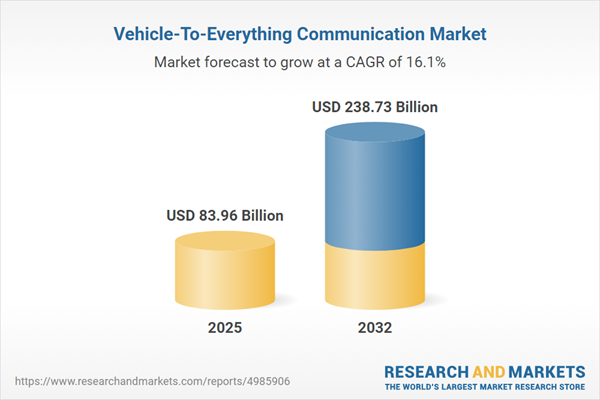Speak directly to the analyst to clarify any post sales queries you may have.
Modern transportation leaders are prioritizing secure, integrated networks to improve efficiency, safety, and digital transformation. The global Vehicle-To-Everything Communication (V2X) market is unlocking new levels of operational intelligence and connectivity for mobility ecosystems.
Market Snapshot: Vehicle-To-Everything Communication Market Trends and Growth
The Vehicle-To-Everything Communication market is projected to increase from USD 72.18 billion in 2024 to USD 238.73 billion by 2032, representing a CAGR of 16.12%. This expansion is underpinned by advances in secure data transfer, the proliferation of advanced sensors, and seamless connectivity between vehicles and digital infrastructure. Both public and private sector investments remain strong, accelerating the roll-out of V2X systems within logistics and urban transportation. An evolving regulatory climate is impacting strategic decisions, prompting organizations to reinforce digital mobility frameworks and adapt to compliance imperatives.
Scope & Segmentation: In-Depth V2X Market Analysis
This research delivers actionable segmentation and critical guidance for executive leaders navigating the V2X communication landscape. Understanding these segments is essential for aligning strategy with transformative market opportunities and emerging digital mobility demands.
- Component Types: Includes V2X modules, onboard units, connectivity hardware, advanced sensor systems, management software platforms, communication protocols, and cybersecurity solutions. Each element delivers foundations for reliable vehicle connectivity and end-to-end system security.
- End-Use Verticals: Addresses automotive manufacturers, logistics providers, ride-hailing platforms, public transit authorities, and road safety agencies. These sectors leverage V2X to enhance operational flows and integrate transport networks, supporting real-time performance improvements.
- Application Areas: Covers connected infotainment, collision prevention, intelligent traffic management, adaptive route planning, and network optimization. These enable more responsive, safe, and efficient transport for people and goods.
- Geographic Regions: Encompasses North America, Latin America, Europe (highlighting the UK and Germany), the Middle East, and Asia-Pacific (with China, India, Japan, Australia, and Southeast Asia). Regional analysis examines regulatory pace, infrastructure maturity, and the influence of regional public–private initiatives as drivers of V2X deployment.
- Leading Companies Profiled: Features Qualcomm Incorporated, NXP Semiconductors N.V., Continental Aktiengesellschaft, Robert Bosch GmbH, DENSO CORPORATION, Texas Instruments Incorporated, STMicroelectronics N.V., Autotalks Ltd., Huawei Technologies Co., Ltd., and Infineon Technologies AG. Their innovation strategies and competitive positioning shape the evolution of the sector.
Key Takeaways for Senior Decision-Makers
- Combining cellular and short-range communications prepares networks for interoperability across varied mobility applications and supports future digital services.
- Adapting to regulatory developments strengthens compliance processes and ensures organizations are equipped to adjust operational strategies quickly as policies change.
- Collaborative partnerships among manufacturers, technology suppliers, and the public sector drive technical standards, support seamless integration, and help secure vehicle ecosystems against cyber threats.
- Advanced V2X deployments are enhancing capabilities in real-time traffic management, optimizing fleets, and enabling scalable driver assistance. These improvements help organizations deliver safer and more efficient mobility services.
- Pursuing targeted partnerships and acquisitions enables organizations to adapt to fast-changing market dynamics and maintain a competitive advantage within the V2X market environment.
Tariff Impact Across the V2X Ecosystem
- Diversifying supplier sources and increasing domestic procurement, especially in North America, help strengthen supply chain resilience as tariff environments evolve.
- Building strong relationships with regional suppliers and maintaining high certification standards contribute to pricing stability and supply continuity during market changes.
- Proactively adapting to regulatory and economic shifts reduces risk exposure and sustains organizational leadership in uncertain climates.
Research Methodology & Data Sources
Insights are drawn from comprehensive secondary research and structured interviews with senior executives across the transportation industry. Expert validation and rigorous triangulation underpin the reliability and relevance of each market finding.
Why This Report Matters
- Enables senior executives to anticipate and manage technological and regulatory transitions within the connected mobility sector.
- Provides a structured basis for investment planning and risk mitigation as organizations modernize infrastructure and operations.
- Delivers actionable strategies for overcoming integration challenges and technical barriers in advanced transport systems.
Conclusion
This report helps organizations accelerate innovation, meet evolving policy requirements, and build strong leadership positions in the dynamic vehicle-to-everything technology landscape.
Additional Product Information:
- Purchase of this report includes 1 year online access with quarterly updates.
- This report can be updated on request. Please contact our Customer Experience team using the Ask a Question widget on our website.
Table of Contents
3. Executive Summary
4. Market Overview
7. Cumulative Impact of Artificial Intelligence 2025
Companies Mentioned
The companies profiled in this Vehicle-To-Everything Communication market report include:- Qualcomm Incorporated
- NXP Semiconductors N.V.
- Continental Aktiengesellschaft
- Robert Bosch GmbH
- DENSO CORPORATION
- Texas Instruments Incorporated
- STMicroelectronics N.V.
- Autotalks Ltd.
- Huawei Technologies Co., Ltd.
- Infineon Technologies AG
Table Information
| Report Attribute | Details |
|---|---|
| No. of Pages | 181 |
| Published | October 2025 |
| Forecast Period | 2025 - 2032 |
| Estimated Market Value ( USD | $ 83.96 Billion |
| Forecasted Market Value ( USD | $ 238.73 Billion |
| Compound Annual Growth Rate | 16.1% |
| Regions Covered | Global |
| No. of Companies Mentioned | 11 |









